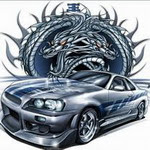

Chevrolet officially announced the 2009 Chevrolet Corvette ZR1 - an American supercar that brings the technology and engineering refinement of carbon-fiber, ceramics and electronics together in a distinctive design.
"Chevrolet's goal with the new Chevrolet Corvette ZR1 is to show what an American supercar can deliver, at a price that trumps exotics that cost two, three or four times as much - and does so with exceptional driveability," said Ed Peper, Chevrolet general manager.
The Chevrolet Corvette ZR1's basic stats:
- All-new LS9 supercharged 6.2L V-8 targeted at producing at least 100 horsepower per liter, or 620 horsepower (462 kW), and approximately 595 lb.-ft. of torque (823 Nm)
- Six-speed, close-ratio, race-hardened manual transmission
- New, high-capacity dual-disc clutch
- Higher-capacity and specific-diameter axle half-shafts; enhanced torque tube
- Specific suspension tuning provides more than 1g cornering grip
- Twenty-spoke 19-inch front and 20-inch rear wheels
- Michelin Pilot Sport 2 tires - P285/30ZR19 in front and P335/25ZR20 in the rear - developed specifically for the Chevrolet Corvette ZR1
- Standard carbon-ceramic, drilled disc brake rotors - 15.5-inch-diameter (394-mm) in the front and 15-inch-diameter (380-mm) in the rear
- Larger brake calipers with substantially increased pad area
- Standard Magnetic Selective Ride Control with track-level suspension
- Wider, carbon-fiber front fenders with Chevrolet Corvette ZR1-specific dual vents
- Carbon-fiber hood with a raised, polycarbonate window - offering a view of the intercooler below it
- Carbon-fiber roof panel, roof bow, front fascia splitter and rocker moldings with clear-coated, exposed carbon-fiber weave
- ZR1-specific full-width rear spoiler with raised outboard sections
- Specific gauge cluster with boost gauge (also displayed on the head-up display) and 220-mph (370 km/h) speedometer readout
- Only two options: chrome wheels and a "luxury" package
- Curb weight of approximately 3,350 pounds (1,519 kg)
Transmission and axle
The LS9 engine is backed by a new, stronger six-speed manual transmission and a twin-disc clutch that provide exceptional clamping power, while maintaining an easy clutch effort. Chevrolet Corvette ZR1-specific gearing in the transmission provides a steep first-gear ratio that helps launch the car, and top speed is achieved in sixth gear - a change from the fifth-gear top-speed run-outs in the manual-transmission Corvette and Corvette Z06.
As the term implies, the twin-disc clutch system employs a pair of discs, which spreads out the engine's torque load over a wider area. This enables tremendous clamping power when the clutch is engaged, while also helping to dissipate heat better and extend the life of the clutch.
The twin-disc clutch system also contributes to the Chevrolet Corvette ZR1's exceptional driving quality, with smooth and easy shifting. The twin-disc system's design enables a 25-percent reduction in inertia, thanks to smaller, 260-mm plates, corresponding to a pedal effort that is similar to the Corvette Z06's 290-mm single-disc system.
The rear axle also is stronger in the Chevrolet Corvette ZR1 and features asymmetrical axle-shaft diameters that were developed after careful testing to provide optimal torque management. The axles are also mounted on a more horizontal plane that correlates with the wider width of the rear wheels and tires.
Ride and handling
The Chevrolet Corvette ZR1 is built on the same aluminum-intensive chassis as the Corvette Z06 and features similar independent SLA front and rear suspensions, with aluminum upper and lower control arms. Where the Chevrolet Corvette ZR1 differs is the suspension tuning, which was optimized for the car's steamroller-wide front and rear tires.
Magnetic Selective Ride Control is standard and tuned specifically for the Chevrolet Corvette ZR1. The system's ability to deliver a compliant ride with nearly instantaneous damping adjustments enabled engineers to develop a surprisingly supple ride quality in a supercar that still delivers cornering grip of more than 1g.
From a high-performance perspective, Magnetic Selective Ride Control helps the rear axle remain planted during launch for smooth, hop-free acceleration. It also helps suppress axle movement when cornering on broken or uneven pavement.
Brakes, wheels and tires
Commensurate with the Chevrolet Corvette ZR1's engine output is the braking system, which is headlined by carbon-ceramic brake rotors. Found on only a few exotics and more expensive supercars, carbon-ceramic brake rotors are made of a carbon-fiber-reinforced ceramic silicon carbide material . Their advantage comes in low mass and resistance to wear and heat. In fact, the rotors should never show any corrosion or require replacement for the life of the vehicle, when used in normal driving.
The vented and cross-drilled rotors on the Chevrolet Corvette ZR1 measure 15.5 inches (394 mm) in diameter in the front and 15 inches (380 mm) in diameter in the rear - making them among the largest carbon-ceramic rotors available on any production vehicle.
Clamping down on the high-tech rotors are six-piston front calipers and four-piston rear calipers, each painted a Chevrolet Corvette ZR1-exclusive blue. The front pads are equivalent in size to the largest on any production car with a single-pad design - double that of the Corvette Z06's 70-sq.-cm. front pads.
The brakes are visible through the Chevrolet Corvette ZR1's exclusive wheels: 20-spoke alloy rims that measure 19 inches in diameter in the front and 20 inches in the rear. They come standard with a bright, Sterling Silver paint finish and chrome versions are optional. The wheels are wrapped in Michelin Pilot Sport 2 tires developed specifically for the Chevrolet Corvette ZR1, measuring P285/30ZR19 in front and P335/25ZR20 in the rear.
Exclusive exterior
The Chevrolet Corvette ZR1 is instantly recognizable, with perhaps the most identifiable feature a raised, all-carbon-fiber hood that incorporates a clear, polycarbonate window. The window provides a view of the top of the engine's intercooler, with the legend "LS9 SUPERCHARGED" embossed on the left and right sides, and an engine cover with the Corvette crossed flags logo debossed at the front.
The underside of the hood has an exposed carbon-fiber-weave. Exposed carbon-fiber is used on the roof, roof bow, rocker molding and front splitter. These exterior components are protected by a specially developed glossy, UV-resistant clear coat that resists yellowing and wear.
Widened, carbon-fiber front fenders with specific, dual lower vents, and a full-width, body-color rear spoiler incorporating the center high-mounted stop lamp, are also unique to the Chevrolet Corvette ZR1. All of the exterior features of the car were developed to enhance high-speed stability and driver control.





























